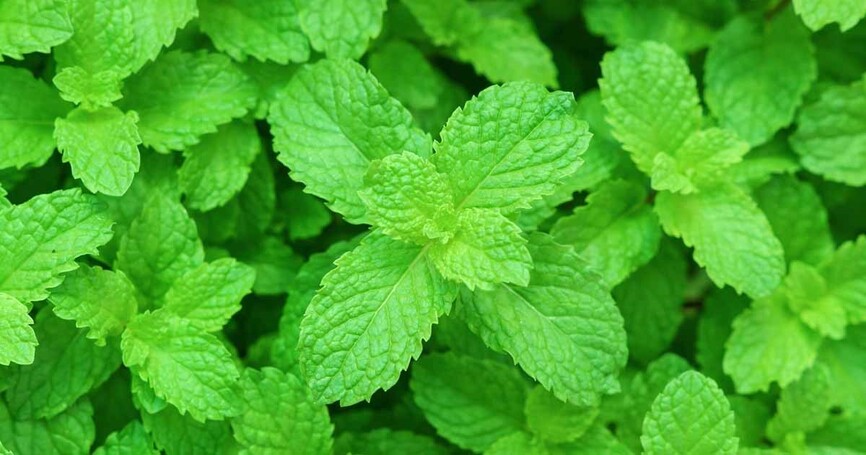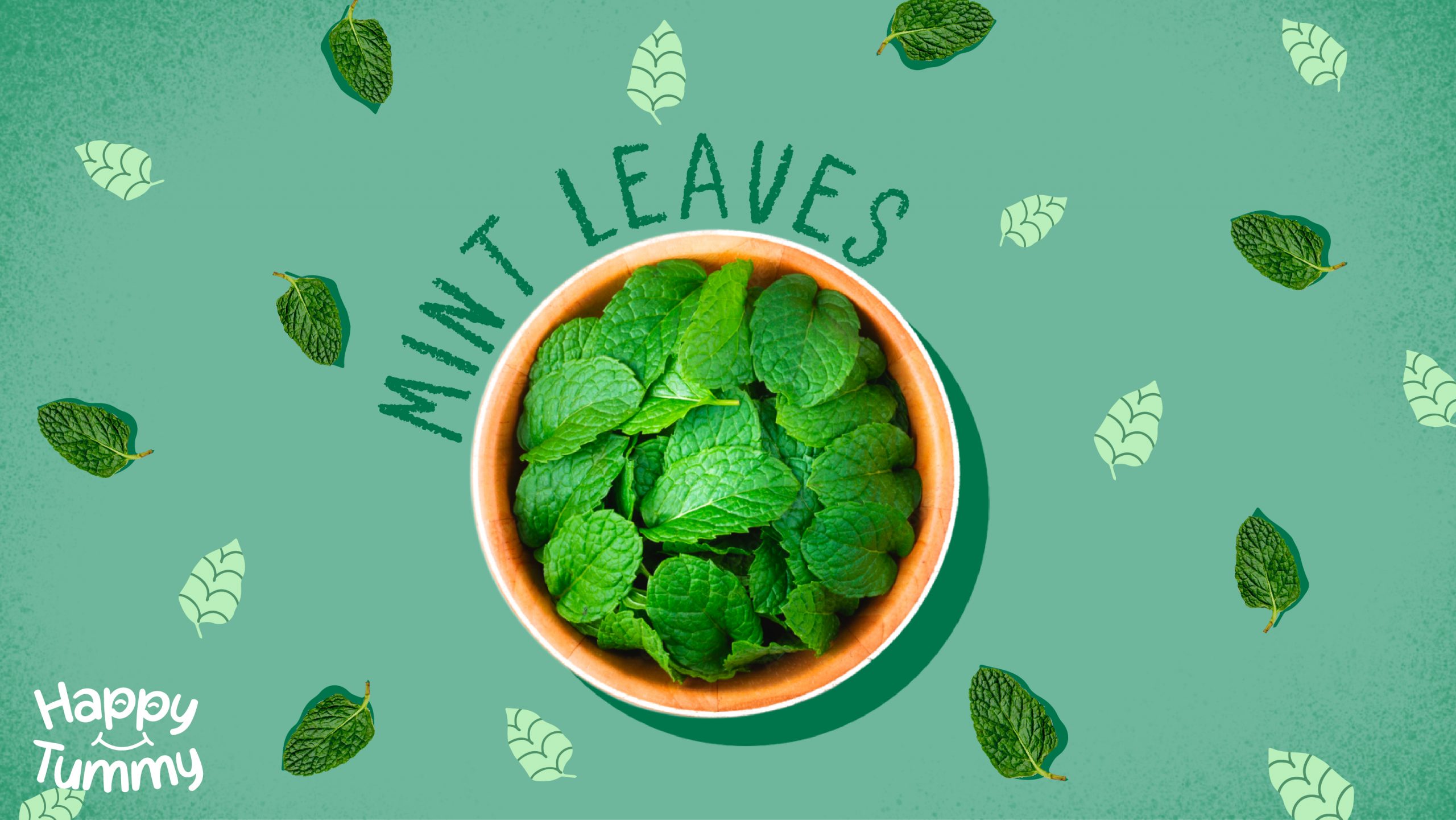Table of Contents
A highlight in any balmy kitchen garden is the vibrant green bee balm that sprouts itself all over the place, makes a perfect trimmed flower, and serves as a delicious tea. Almost anything can be made right with a sprinkle of citrusy, delicious, and cooling mint leaves. Because of its several medical benefits, the herb has been utilized as a potent cooking ingredient ever since it was found. The vivid green leaves are thought to have “healing powers” and soothing effects.
Mint is a native of the eastern Mediterranean and originates from the mythical nymph Minthe (Mintho). Fresh mint leaves typically have a vivid green color and little bristles that give them a smooth feel when touched. Mint is an annual plant with aromatic, “toothed” leaves and teeny-tiny lavender, pink, or white blooms on occasion. The mint leaves may also be glossy, fluffy, smooth, curled, green, or varied, frequently with red or purplish hues, depending on the type.

How Does Mint Taste?
Mint has always been more than simply a flavor; it has a pleasant aroma and medicinal properties. Yes, mint has a strong scent, but so do basil, oregano, cinnamon, and lavender. So… How did mint become the flavor of choice for almost all toothpaste in the market?
That is because.. menthol, a peculiar molecule, and the cooling effect it produces. Because we associate a cool sensation with freshness, mint leaves can make our mouths seem pristine even when they aren’t.
Mint has a sweet flavor that is refreshing, juicy, and aromatic. On the palate, it leaves a persistent chilly and tingling sensation. In contrast to spearmint, which is typically lighter, calmer, and softer, peppermint has a chilly and menthol flavor.
What Are The Health Advantages of Mint leaves?
Have you ever wondered how much nourishment is in those tiny, vibrant leaves in your kitchen garden? Mint leaves are a great addition to vegan, vegetarian, and keto food in addition to being a gluten-free herb and helping to improve digestion, vision, cognitive function, and, of course, terrible breath. Let’s explore fifteen scientifically proven health advantages of mint leaves.
1. Mint Leaves Remedy for In-digestion
Mint leaves are renowned for being a fantastic appetizer. Encouraging digestive juices, it supports the digestion process. Mint oil has antiseptic and antibacterial characteristics that help to treat intestinal ailments, gastritis, and other conditions. Because methanol is present, mint leaves have anti-spasmodic properties. The body utilizes bile to break down fats, and peppermint eases abdominal muscles and increases bile flow, resulting in food digesting more quickly in the stomach.
2. Can Mint Leaves Ease Irritable Bowel Syndrome?
Yes, it soothes the stomach ache that causes restlessness. The digestive system frequently suffers from irritable bowel syndrome. A dietary change is a primary and most effective therapy for irritable bowel syndrome; nevertheless, some researchers have suggested that mint oil may also be beneficial. Researchers believe mint leaves‘ anti-spasmodic qualities are primarily responsible for the herb’s ability to relieve IBS symptoms, including bloating and constipation. The menthol in mint leaves helps to soothe the muscle fibers of the intestine.
The menthol in mint leaves helps to soothe the muscle fibers of the intestine.
3. Mint Leaves Reduce Respiratory Issues
Mint leaves are strongly suggested for those with asthma since they help to soothe and reduce chest tightness. Patients with asthma can have a calming effect from a daily intake of mint. Menthol and mint are both believed to help people breathe more easily. It also soothes the discomfort brought on by a persistent cough.
4. Are Mint Leaves Effective for Oral Care?
Have you ever tried chewing mint leaves to escape the pungent smell? Having germicidal qualities, mint could assist in rapidly freshening your breath. Extract from mint leaves can assist in removing dental plaque. Dental bacterial growth can be stopped, and your cavities can be kept clean using toothpaste, mouthwash, or chewing gum containing menthol.
5. Mint Leaves Boost Cognitive Function
Mint leaves are a brain stimulant that improves mental clarity and alertness when consumed. The essential ingredient is the aroma of mint. The smell activates the brain’s hippocampus region, which governs mental acuity and memory, especially long-term memory. In essence, the smell of peppermint, especially the menthol component, makes you alert and pay attention.
6. Are Mint Leaves Immunity Boosters?
Mint has many vitamins and antioxidants that boost immunity. These vitamins from plants aid in cell damage prevention. Mint leaves can also stop the growth of tumors by blocking certain enzymes.
7. Mint Leaves Reduces Stress
Mint plays a crucial role in aromatherapy. Its powerful and energizing aroma may reduce stress and revive the mind. Your thoughts are quickly relaxed when you inhale the perfume of mint. For instant anxiety and stress alleviation, try adding mint leaves to your tea, using mint extract in a vaporizer, or taking a mint bath.
8. Mint Leaves Reduce Pain During Breastfeeding
Breastfeeding can be uncomfortable and challenging for mothers with sensitive and bruised nipples. Evidence suggests that mint essential oil on aching muscles and damaged nipples can help relieve pain.
9. Can Mint Leaves Help You Lose Weight?
Mint leaves can be your weight-loss trump card. It promotes the digestive enzymes, which ingest fat and absorb nutrients from meals to produce utilizable energy. Mint tea is a beautiful, calorie-free, mood-refreshing beverage to encourage weight loss by improving digestion and metabolism.
10. Mint Leaf for Skincare
Mint is a traditional remedy for skin issues, including acne and scars. They have potent antibacterial, antifungal, and anti-inflammatory qualities that can effectively treat acne and reduce the swelling and redness brought on by acne flare-ups. The high citric acid and vitamin A content of mint leaves helps to treat acne by regulating the production of jojoba oil in the skin. Its abundance of menthol and organic antioxidants makes them an excellent skin cleanser, purifier, exfoliant, and moisturizer. Mint soothes dry, irritated skin and tone it.
11. Mint Leaves for Healthy Hairs
Carotene and antioxidants included in mint leaf extract help to stimulate hair development and stop hair loss. You can apply a paste made of mint leaves and lemon juice to the hair scalp and keep it on for 30 to 40 minutes before rinsing it thoroughly. With the help of mint strong antibacterial and antifungal capabilities, you can prevent dandruff, head lice, and other nasties.
12. Mint Leaves for Morning Sickness
An effective treatment for nausea is mint. The anti-nausea vitamin B6 in the organic mints can help prevent nausea and morning sickness.
13. Mint Leaves Help Ease Allergies
Look nowhere if you are suffering from persistent allergies. Mint oil works amazingly and provides relief right away. It is well known that the essential oils found in mint prevent the body from releasing particular molecules that cause hay fever and seasonal allergies, often known as rhinitis. To combat allergies, it’s recommended to take mint, either fresh and uncooked or in the form of mint tea.
14. Mint Leaves Help Reduce Nasal Congestion
People with asthma can benefit significantly from the relaxing effects of mint leaves, which also help to clear nasal congestion. The amount and frequency of mint use must be controlled, though, as excessive use may cause stomach and nose irritation.
15. Are Mint Leaves Nutritious?
Yes… Mint leaves are heaped with nutrients. According to the nutritional information about spearmint, also known as mint, it can offer a good amount of nutritious nourishment.
Two tablespoons of mint contain
|
NUTRIENTS |
VALUE |
|---|---|
|
Proteins |
0.4 grams |
|
Carbohydrates |
0.9 grams |
|
Dietary fiber |
0.8 grams |
|
Vitamin C |
1.5 mg |
|
Calcium |
22.4 mg |
|
Phosphorous |
6.8 mg |
|
Potassium |
6.8 mg |
What Recipes can be Using Mint Leaves?
Members of the mint family are used widely as a seasoning, flavoring, and fragrance component because many, if not most, contain highly fragrant oils. Although fresh mint tastes fantastic in stews, blended into cocktails and lettuce, those recipes don’t call for much of it. Here are six inventive ways to use plenty of mints, retaining its springtime flavor throughout the upcoming autumn and winter and appreciating its vibrancy.
1. Mint Lassi
Lassi is the preferred liquid in north India and is the epitome of a summer refreshment containing mint leaves, which are believed to stimulate hunger. Mint lassi, made by blending curd, sugar, and mint, and garnishing it with cumin and fresh mint leaves, can be the perfect addition to a classy Sunday breakfast.
2. Lemonade with Mint and Kiwi
What are summers without a smidgen of lemon? And it will undoubtedly be a cooling combo if you add a dash of mint. This recipe for lemonade is made with fizzy water and is loaded with mint, lemon, and zesty kiwis. If you make this at home, you won’t require any other beverage to keep you cool.
3. Mint Chutney
Consider a feast without curries and chutneys. Obviously not! A spicy chutney and achaar on the table are nearly always required to make Indian cuisine perfect. This mint recipe is the perfect way to liven up your next dinner. Coriander, plums, and syrup make mint and turmeric chutney.
4. Mint Rice
You may make this delectable comfort food at home when you’re too tired to cook a fancy meal or feel queasy. A delicious and nutritious lunch option is mint rice, a tasty delicacy with spicy mint paste, cumin, lemon, and rice.
FAQs
1. Can you consume raw mint leaves?
Although eating mint leaves is generally healthy, people with gastroesophageal reflux illness should restrict their consumption since it may upset their stomachs. Menthol oil shouldn’t be given to kids orally because it can make them have breathing problems.
2. Is drinking mint tea made from boiled leaves healthy?
Yes. Boiling fresh mint leaves in water and drinking the resulting mix at your preferred temperature all day long is the simplest way to incorporate mint into your diet. Given its cooling and refreshing qualities, it might be a healthy alternative to carbonated drinks and other drinks that could negatively impact your health.
3. What advantages does consuming mint water have?
An excellent method to take advantage of mint’s digestive properties is to drink mint water. Menthol, a component of mint water, helps treat irritable bowel syndrome. It can aid with indigestion relief and relieves some IBS symptoms.
4. Can you eat mint every day?
The ideal method is consuming 12 to 15 fresh mint leaves daily. You can even eat them by including them in herbal teas, yogurt, juices, stews, soups, dressings, and condiments, among other things.
5. Can I have mint tea at night?
Mint has antiviral, antibacterial, and anti-inflammatory characteristics, which can aid in relieving congestion, stress, and pain. You will undoubtedly experience more energy in the morning and all day if peppermint tea is a regular component of your nighttime regimen to encourage better sleep.















